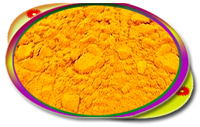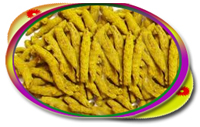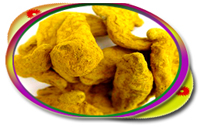| |
 Turmeric , the dried rhizome of a herbaceous perennial, is indigenous to Southeast Asia. The primary rhizomes, rounds in shape are called 'Bulbs , while the thin, long secondary rhizomes are called 'bulbs', while the tin, long secondary rhizomes are called 'fingers'. After harvest, the rhizomes are cleaned, boiled, dried and polished. Turmeric is closely related to ginger and is sometimes called Indian saffron due to its brilliant yellow colour. Turmeric , the dried rhizome of a herbaceous perennial, is indigenous to Southeast Asia. The primary rhizomes, rounds in shape are called 'Bulbs , while the thin, long secondary rhizomes are called 'bulbs', while the tin, long secondary rhizomes are called 'fingers'. After harvest, the rhizomes are cleaned, boiled, dried and polished. Turmeric is closely related to ginger and is sometimes called Indian saffron due to its brilliant yellow colour.
The propagation of turmeric is by rhizomes
| Botanical Name |
: |
Curcuma Longa |
| Family |
: |
Zingiberaceae |
| Parts Used |
: |
Rhizome |
 |
| |
 Turmeric has been used worldwide since very ancient times. Several unique properties of the Indian turmeric make it an ideal choice as a food flavour. It also finds use in the preparation of liquors, dyestuffs, medicines, cosmetics and toiletries. It is used as natural colourant. The curcumin present in turmeric imparts its distinctive yellow colour. In beauty care, Indian women have used turmeric paste since very ancient times. Today it finds use as an antiseptic and in antitanning. It prevents and cures pigmentation, making skin translucent and glowing. It cools and smoothes the skin. It is used to purify blood. It also helps in protecting the skin from water allergy. Turmeric has been used worldwide since very ancient times. Several unique properties of the Indian turmeric make it an ideal choice as a food flavour. It also finds use in the preparation of liquors, dyestuffs, medicines, cosmetics and toiletries. It is used as natural colourant. The curcumin present in turmeric imparts its distinctive yellow colour. In beauty care, Indian women have used turmeric paste since very ancient times. Today it finds use as an antiseptic and in antitanning. It prevents and cures pigmentation, making skin translucent and glowing. It cools and smoothes the skin. It is used to purify blood. It also helps in protecting the skin from water allergy. |


